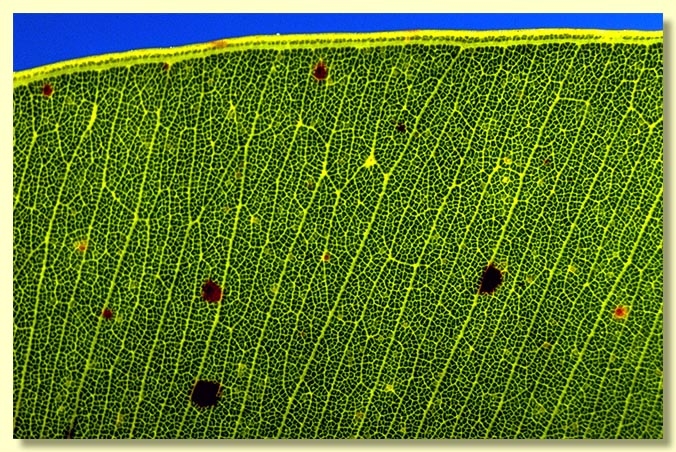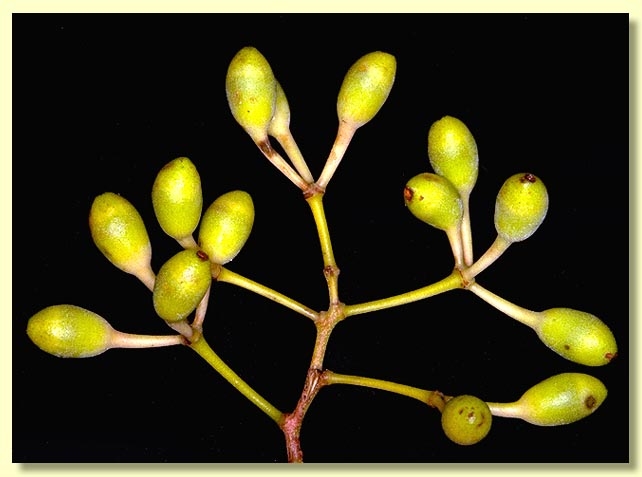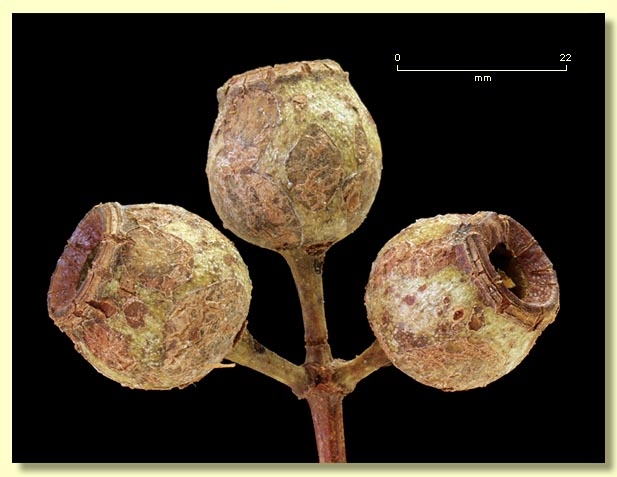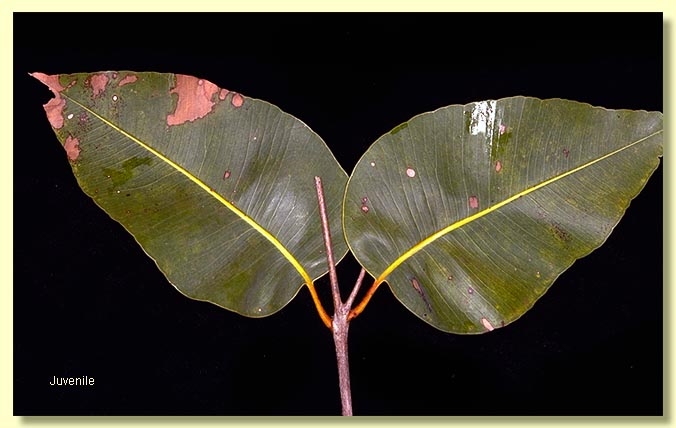Euclid - Online edition
Corymbia porrecta
Corymbia | Rufaria
Corymbia porrecta (S.T.Blake) K.D.Hill & L.A.S.Johnson, Telopea 6: 270 (1995).
Tree to 20 m tall but often smaller. Forming a lignotuber. Root system forming rhizomes.
Bark rough to the small branches, tessellated, grey over grey-brown, to red-brown underneath.
Branchlets lack oil glands in the pith.
Juvenile growth (coppice or field seedlings to 50 cm): stems rounded to square in cross-section, smooth; juvenile leaves always petiolate, opposite or becoming alternate, ovate, 18–25 cm long, 11–17 cm wide, base truncate to rounded, apex pointed or rounded, green, smooth.
Adult leaves alternate, petioles 1.7–3.5 cm long; blade broadly lanceolate to ovate, 9–23.5 cm long, (1.8)3–8.5 cm wide, base tapering to petiole, margin entire, apex pointed, slightly discolorous or concolorous, glossy, green, smooth, side-veins greater than 45° to midrib, reticulation very dense, intramarginal vein present and close to margin or scarcely visible above but clearer on underside, oil glands usually visible, small, island, one per areole.
Inflorescence terminal compound, peduncles 0.6–3.5 cm long; buds 7(9) per umbel, prominently pedicellate (pedicels 0.4–2.2 cm long). Mature buds obovoid to ovoid or pyriform, 1–1.5 cm long, 0.7–0.9 cm wide, smooth, scar absent (both opercula shed together at flowering), operculum rounded to conical, stamens inflexed, all fertile, anthers oblong, dorsifixed, versatile, dehiscing by longitudinal slits, style long and straight, stigma blunt and long-papillose, locules 4(5), the placentae each with ca 7 ± indistinct vertical ovule rows. Flowers creamy white.
Fruit pedicellate (pedicels 0.4–2.6 cm long), urceolate to barrel-shaped or truncate-globose, contracted above to form a short neck that is not flared at rim, or lacking a neck and then isodiametric, 1.8–3 cm long, 1.5–2.6 cm wide, thick-walled, ± smooth, disc descending vertically or obliquely, valves 4(5), enclosed.
Seeds brown, 11–16 mm long, ellipsoidal with terminal wing, hilum ventral.
Cultivated seedlings (measured at ca node 10): cotyledons reniform; stems rounded in cross-section, setose with short bristle-glands for 10 or more nodes; leaves always petiolate, opposite for at least 10 nodes, broadly elliptical to lanceolate, 5.5–12 cm long, 2.5–5.5 cm wide, base tapering to petiole or rounded to truncate, green, setose with bristle-glands on both surfaces.
Flowering has been recorded in January, February, March and April.
A bloodwood tree endemic to lowland areas of the monsoonal Top End of the Northern Territory from Litchfield and Darwin east to Jabiru and north to Cobourg Peninsula, and on Bathurst and Melville Islands. It is found in woodlands on shallow sandy/gravely soil on flat or slightly rising ground. Corymbia porrecta has quite rough greyish, tessellated bark extending to the small branches, alternate, petiolate crown leaves that are large, glossy, green, not or only slightly paler on the underside, and with the intramarginal vein weakly visible, large smooth buds on long pedicels, and robust thick-walled urceolate to barrel-shaped or truncate-globose 1.5–2.6 cm wide, truncate or sometimes slightly contracted to form a short neck but rim never flared.
Within the natural range of C. porrecta there are few other bloodwood species that have alternate, petiolate crown leaves and rough bark extending to the small branches. These are C. ptychocarpa subsp. aptycha, which has large scurfy buds, red to pink or cream flowers, fruit 2.2–3.8 cm wide, and crown leaves clearly darker green above and paler beneath; C. polycarpa, which also has leaves darker green above and paler on the underside, cylindrical scurfy buds and elongated narrowly barrel-shaped fruit to 1.6 cm wide; C. cliftoniana from the drier, sandstone areas of the Victoria River region and adjacent Kimberley region of tropical north-western Australia, differing in the concolorous green dull leaves lacking an intramarginal vein, and more spherical fruit of similar diameter to those of C. porrecta; and C. nesophila, which occurs on the northern fringe of the Northern Territory and adjacent islands and which has crown leaves only slightly paler on underside with intramarginal vein visible but close to margin, buds that are smooth and fruit quite small being only 0.6–1 cm diameter. Other fully rough-barked bloodwood species in the Top End area have opposite ± sessile crown leaves, i.e.C. abbreviata, C. ferruginea, C. chartacea, C. dunlopiana and C. papillosa.
C. porrecta, unusually for a eucalypt, develops rhizomes. The form, growth and development of the rhizomes and their role in regrowth of the species after fire was reported in a landmark scientific paper by Lacey (1974). The regrowth shoots bear large juvenile leaves.
MORE ABOUT CORYMBIA
MORE ABOUT RED BLOODWOODS
Corymbia porrecta: Latin porrectus, stretched outwards and forward, perhaps referring to the long, broad leaves of the crown.

















